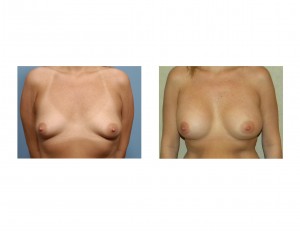Background: The desire for larger breasts is very effectively achieved through the placement of implants behind the breast tissue/mound. This will create a larger and rounder breast mound but that is usually the limit of what it actually achieves. Implants have little capability to do much breast lifting and it can not change the position of the breast mound on the chest wall. In essence, implants take many of the natural features of one’s breast and just make it bigger. (which may or may not be necessarily better)
Of the many favorable breast shape features is the desire for cleavage. Few natural breasts actually have cleavage outside of a bra. But when women undergo breast augmentation they often expect that cleavage will result. But this actually uncommonly happens unless one has breasts that are naturally very close together, very large implants are placed or the implants are placed above the muscle in the subglandular position close to the sternum.
Before breast augmentation surgery, it is very important to look at the spacing between the breast mounds. This can be somewhat difficult in very small breasts where little mound tissue in present. But the key is the position of the nipple-areolar complex in reference to an imaginary vertical line dropped down from the middle of the clavicle bone. If the nipple-areolar complex sits along this vertical line, some cleavage may potentially result. But if it sits outside of this line, cleavage can not result because the breast mounds are just too far apart.
Case Studies: This 42 year-old female wanted larger breasts through implants. Her breasts had gotten a little smaller and slightly saggy after she had children and was a little older now. Besides her slight breast sagging was the more noticeable finding of very widely positioned nipple-areolar complexes. Her breast mounds were pointed to the sides of her chest with a large intramound sternal gap. It was pointed out to her that any amount of cleavage would not be the result of her surgery.


While cleavage is a desired result from any breast augmentation procedure, it often is not possible. In the very widely spaced breasts not only will cleavage not be created but the focus is on preventing implant placement too far to the side of the breasts which would magnify the breast mound spacing even further.
Case Highlights:
1) Breast implants make larger breasts but will not usually make cleavage without the use of a bra.
2) The spacing of one’s natural breasts determines whether implant placement will have a cleavage effect.
3) Cleavage can be more effectively created by implants placed above the pectoralis muscle if that is an important breast shape feature.
Dr. Barry Eppley
Indianapolis, Indiana


